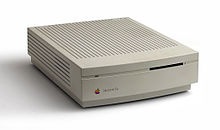Macintosh IIsi
Macintosh II si is the name of a computer produced by Apple .
The computer, clocked at 20 MHz and based on the Motorola 68030 , with a working memory of 65 MB at maximum expansion was presented by Apple in October 1990. A PDS slot was available for expansion, which could be converted to a NuBus port using an adapter . In addition to the 8-bit color graphics card on the motherboard , the IIsi, like all computers in the II series, offered an 8-bit stereo sound system. Hard disks, CD-ROM drives, scanners or streamers could be connected to the external SCSI bus output .
The Mac IIsi was a stripped-down version of the Macintosh IIci - as an inexpensive alternative for private users. In order to keep costs low, the graphics shared the memory bandwidth with the CPU, as with the IIci. In particular, the higher resolutions and color depths were slower than with the IIci. The on-board graphics could be operated with a maximum resolution of 640 × 480 pixels at 8 bit or 640 × 870 monochrome. Apple offered various monitors for the device's 15-pin video output: a color monitor with a resolution of 512 × 384 pixels and two monochrome monitors with 640 × 480 or 640 × 870 pixels. There was an additional NuBus or LC-PDS slot on the expansion board together with the 68882 coprocessor. 1 MB of RAM was firmly soldered to the motherboard. The CPU of the IIsi was clocked with 20 instead of 25 MHz as with the IIci, although the parts used were designed for the 25 MHz processor clock. This is why overclocking (often up to 25 or 28 MHz) of the IIsi was widespread, also because the common access of CPU and graphics to the memory then worked much better and the graphics output was noticeably faster.
The newly designed motherboard of the Mac IIsi had a PDS expansion slot, for which special cards with the mathematical coprocessor Motorola 68882 or bridge card were offered and could be plugged into the processor direct slot , as well as an internal standard NuBus slot that included was compatible with the other Macs of the IIsi series. The IIsi was offered with either a 40 or 80 MB hard disk and a 1.44 MB floppy disk drive .
With the exception of the IIci, the IIsi was one of the first Macs with an audio input, which sometimes caused problems if the speaker contacts wore out over a long period of time, which then led to loss of sound output. This could only be remedied by cleaning the contacts and treating them with conductive silver . The first ROMs available were often faulty, which even made it impossible to start the system. Although Apple soon added a special ROM-SIMM to later boards to compensate for errors, the slot for the ROM-SIMM was retained.
| introduction | October 15, 1990 |
| End of production | March 15, 1993 |
| Apple end of support | September 1, 1998 |
| Price at that time | approximately $ 3,500 |
| CPU | 68030 (at 20 MHz clock frequency) |
| FPU | Motorola 68882 (optional) |
| L1 cache | 512 bytes |
| bus | 20 MHz |
| slot | 1 NuBus or: 1 LC PDS |
| R.A.M. | 1 MB, 4 thirty-pole SIM slots (expandable to 65 MB) |
| VRAM | 64-320 kB |
| Video | 640 × 480 pixels, 8 bit (color), 640 × 870 monochrome |
| Ports |
|
| Expansion slot |
|
| Floppy disk drive | 1.44 MB ("SuperDrive"), 3.5 inches |
| hard disk | 80/40 MB, SCSI |
| power adapter | 160 W |
| Weight | approx. 5 kg |
| Dimensions (L × W × H) | approx. 10.1 cm x 31.5 cm x 37.8 cm |
| ROME | 512 KB |
| Video memory | 1 MB, supports the resolutions 512 × 384 pixels and 640 × 480 pixels with 8 bit each |

